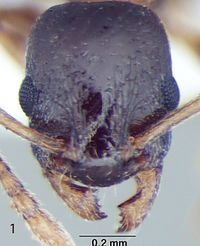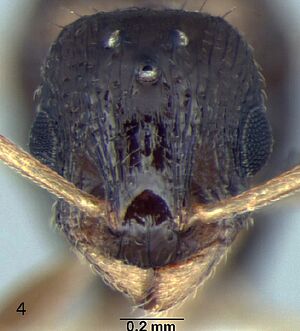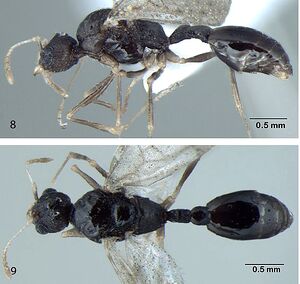Temnothorax simlensis
| Temnothorax simlensis | |
|---|---|

| |
| Scientific classification | |
| Kingdom: | Animalia |
| Phylum: | Arthropoda |
| Class: | Insecta |
| Order: | Hymenoptera |
| Family: | Formicidae |
| Subfamily: | Myrmicinae |
| Tribe: | Crematogastrini |
| Genus: | Temnothorax |
| Species: | T. simlensis |
| Binomial name | |
| Temnothorax simlensis (Forel, 1904) | |
Temnothorax simlensis can be found nesting under the same stones as Myrmica aimonissabaudiae and Myrmica cachmiriensis but their nest-chambers are unconnected, i.e., the species have a plesiobiotic relationship.
Identification
Bharti et al (2016) - Temnothorax rothneyi and T. rothneyi simlensis occur sympatrically in Himalaya, where they are both endemic. These two forms also exhibit consistent morphometric and morphological characters (as outlined in the Key to Temnothorax of India) for both the workers and gyne. Collectively, these distinctions merit raising T. rothneyi similensis to species rank.
Keys including this Species
Distribution
India (Himalaya)
Distribution based on Regional Taxon Lists
Oriental Region: India (type locality).
Distribution based on AntMaps
Distribution based on AntWeb specimens
Check data from AntWeb
Countries Occupied
| Number of countries occupied by this species based on AntWiki Regional Taxon Lists. In general, fewer countries occupied indicates a narrower range, while more countries indicates a more widespread species. |

|
Estimated Abundance
| Relative abundance based on number of AntMaps records per species (this species within the purple bar). Fewer records (to the left) indicates a less abundant/encountered species while more records (to the right) indicates more abundant/encountered species. |

|
Biology
Ecology: The nests of this species were located on a hill slope covered with grasses and stones, in a temperate forest, which comprises mostly of Pinus and Cedrus trees. The nests were small, usually 4 to 5 inches deep with low abundance of workers. The recorded nest temperature ranged from 14°C to 28°C and relative humidity from 42% to 91%. This species has been observed to share a plesiobiotic association with two of the Myrmica species (Myrmica aimonissabaudiae and Myrmica cachmiriensis) distributed in the region, where these different ant species nest very close to each other under the stones, but are not engaged in direct communication, unless their nest chambers are broken open, in which case fighting and brood capturing have been observed.
Castes
Queen
 
| |
| . | |
Male
 
| |
| . | |
Nomenclature
The following information is derived from Barry Bolton's Online Catalogue of the Ants of the World.
- simlensis. Leptothorax rothneyi var. simlensis Forel, 1904c: 22 (w.) INDIA.
- Status as species: Bharti, Gul & Sasi, 2016: 749.
Description
Unless otherwise noted the text for the remainder of this section is reported from Bharti et al (2016)
Material examined: India: Himachal Pradesh: Kothi, 2600m, 9(w), 1(q), 1(m), 23.vi.2010 (collected by Irfan Gul), 5(w), 27.vi.2014, 4(w), 16.vi.2015 (collected by Sishal Sasi) in PUAC. Syntypes (MHNG): Shimla, casent 0909055- T. rothneyi simlensis; Mussorie, casent 0909054- T. rothneyi.
Worker
(n=9): HL 0.69-0.75; HW 0.55-0.59; SL 0.51- 0.57; WL 0.74-0.80; PNW 0.41-0.47; PL 0.41-0.47; PPL Figs A-C. Measurements of different body parts. 0.21-0.24; PH 0.17-0.21; GL 0.90-0.96; PSL 0.054-0.06; CI 125-130; SI1 71-75; SI2 93-98; PSLI 9-10; TL 2.86-3.04.
Head: Head subrectangular in full face view; posterior margin of head slightly convex; narrowly round posterolateral corners; lateral sides almost parallel; anterior clypeal margin broadly rounded; eyes situated about the middle on the sides of the head; mandibles triangular, the masticatory margin with 5 prominent teeth; antennae 12 segmented, scape short, barely reaching posterior margin of head.
Mesosoma, petiole and postpetiole: Mesosoma with slightly convex dorsum anteriorly, posteriorly fairly straight; metanotal groove shallow but distinct; humeri in dorsal view rounded; propodeal spines short, dentate, as long as 1/4 the range of their bases; petiolar node longer than high with short anterior peduncle; petiolar node in profile with steep and very slightly concave anterior face and somewhat rounded, thicker dorsum; postpetiolar node as high as petiolar node, with the rounded dorsum and wider than petiolar node; gaster somewhat ovate, smooth and shiny.
Sculpture and pilosity: Head rugulose and reticulated except for the space in between frontal carinae up to posterior side of frons and the median clypeus which are smooth; mandibles with distinct rugosity; clypeus longitudinally rugose except for the median portion; Mesosoma rugulose and reticulated all over; petiolar and postpetiolar nodes finely reticulated; head and Mesosoma punctulate; gaster smooth and shiny; suberect to erect hairs scattered over the whole body; decumbent pubescent hairs on antennae and legs, more dense on antennal funiculus.
Colour: The front of the mesosoma, mandibles, antennae, legs, petiole, postpetiole and anterior 1/5 of the gaster yellowish brown; rest of the body dark brown to black in colour; pilosity pale white
Queen
(n=1): HL 0.79; HW 0.66; SL 0.56; WL 1.32; PNW 0.84; PL 0.42; PPL 0.29; PH 0.25; GL 1.62; PSL 0.054; CI 119; SI1 71; SI2 85; PSLI 8; TL 4.4.
Resembles the worker, with modifications expected for caste and with the following differences: Body massive, hairy; scattered longitudinal rugae covering the head except for the frons and antennal hollows which are smooth with a few indistinct rugulae; eyes large and bulging; three prominent ocelli positioned as making a triangle on frons; mesosomal dorsum weakly rugulose anteriorly, posteriorly smooth; rugulose on sides and around propodeal spines with some patches smooth on sides; propodeal spines dentate; petiolar, postpetiolar nodes dull due to weak sculpture on the nodes; hairs of varying lengths cover entire body; mesosoma without any constriction, very robust, with raised scutellum interrupting the regular convexity above; propodeal declivity very steep; petiolar node broadly round, postpetiolar node very broad; gaster long and gibbous; colour dark brown to black all over with a yellowish patch on anterior segment of gaster and on the middle of mesosoma; legs and antennae yellow except for the femori which are brown.
Male
(n=1): HL 0.53; HW 0.51; SL 0.20; WL 1.12; PNW 0.72; PL 0.28; PPL 0.26; PH 0.16; GL 1.15; PSL 0; CI 103; SI1 38; SI2 39; PSLI 0; TL 3.34.
Head broadly oval and converging posterior to eyes in full face view; posterolateral corners rounded; eyes very large, bulging beyond head outline in full-face view; three prominent ocelli present on frons; antennae 13 segmented, filiform, scapes short, failing to reach the posterior margin of head; clypeus broadly rounded anteriorly; mandibles with 5 teeth; mesosoma enlarged to accommodate flight muscles; pronotum small; scutum smooth; scutellum raised, declivity steep; propodeal spines indistinct; petiolar node indistinct, very low, postpetiolar node, broad, low; gaster lengthened; colour black all over; antennae and legs yellowish brown; wings transparent with a creamish glare; body shiny, head with microreticulation; clypeus smooth with a few carinae; mandibles with indistinct rugosity; petiolar and postpetiolar nodes finely reticulated; mesosoma and gaster smooth and shiny.
References
- Bharti, H., Gul, I., Sasi, S. 2016. Taxonomy of Temnothorax simlensis stat. nov. (Hymenoptera: Formicidae) with first description of sexual castes along with a mention of its plesiobiotic association with Himalayan species of genus Myrmica. Sociobiology 63(2): 748-754 (doi:10.13102/sociobiology.v63i2.869).
- Bolton, B. 2003. Synopsis and Classification of Formicidae. Mem. Am. Entomol. Inst. 71: 370pp (page 271, Combination in Temnothorax)
- Forel, A. 1904d. Miscellanea myrmécologiques. Rev. Suisse Zool. 12: 1-52 (page 22, worker described)

